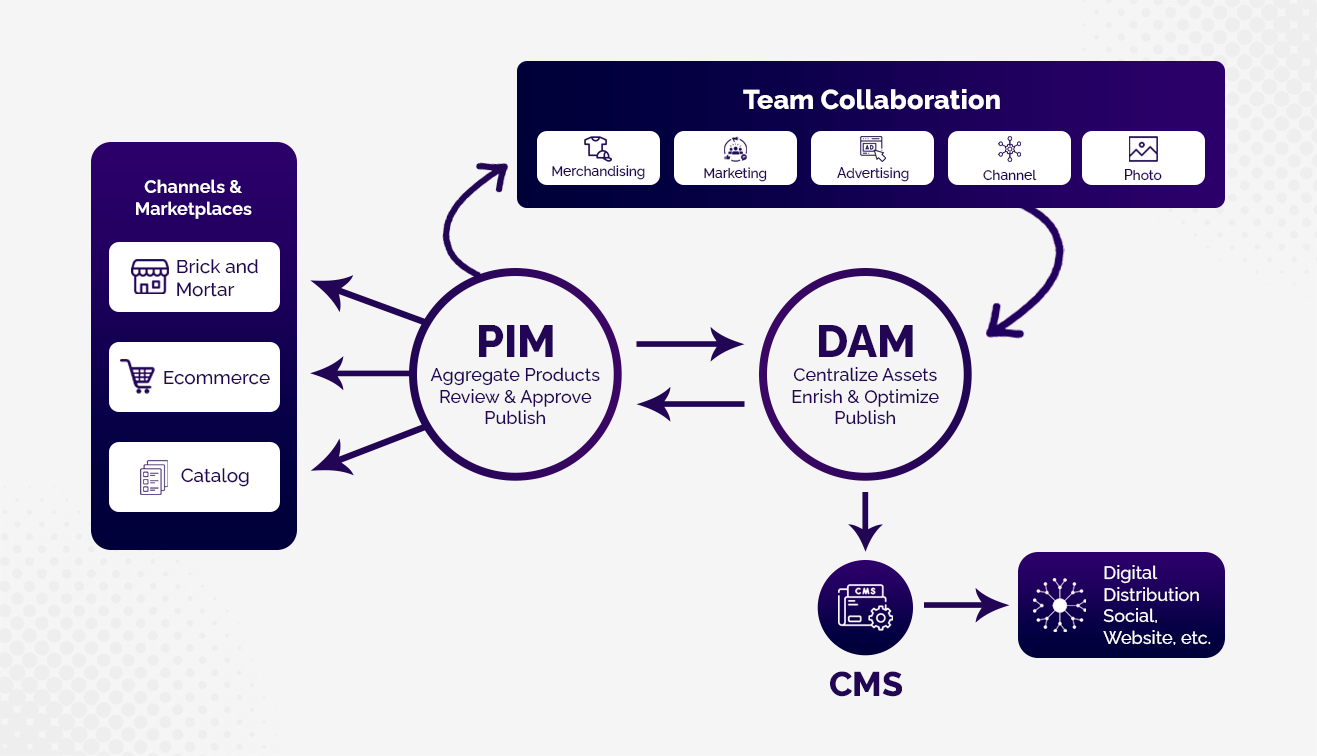In today's digital landscape, businesses are dealing with an ever-increasing volume of digital assets and product information. Managing this data is like walking a tightrope. As organisations struggle to effectively manage and utilize these valuable resources, PIM and DAM play a crucial role in streamlining operations and handling huge amounts of data seamlessly.
While both PIM and DAM serve as repositories for data, they serve different purposes and cater to distinct aspects of business management. As per Webinarcare Report, PIM solution is 100% concentrated on the management of product information that enhance marketing and merchandising purposes.
Let’s explore the key differences between PIM and DAM and highlight their unique features and benefits.
What is Product Information Management (PIM)?
PIM is a software solution designed to centralize, manage, enrich and distribute product data. It acts as a single source of truth for all product-related information, ensuring consistency and accuracy across multiple sales channels. PIM systems focus on organizing, categorizing, and structuring data like product descriptions, specifications, pricing, and inventory details. The primary objective of PIM is to optimize product data for sales and marketing activities, improving customer experiences and streamlining internal workflows.
Benefits of PIM:
• Enhance the customer journey and deliver a consistent brand experience across all touchpoints with the time-saving capabilities of PIM.
• Empower vendors and suppliers through self-service capabilities and seamless contact accessibility, facilitated by PIM technology for comprehensive organizational ecosystem support.
• Accelerate marketing efforts with PIM by integrating product information into a centralized system, enabling quick market responses, easy market entry, and efficient product portfolio expansion.
• Effortlessly syndicate standardized product data across leading global shopping networks, enabling broad audience reach, customization options, and seamless distribution to various channels and markets, all facilitated by modern PIM systems.
• Create a customer-centric product experience, streamline data management, and leverage enriched information from a centralized PIM system to drive engaging marketing campaigns, launch new products, and deliver fulfilling customer experiences, ultimately leading to higher ROI.
What is Digital Asset Management (DAM)?
DAM, on the other hand, is a software solution that centralizes, organizes, and provides access to digital assets such as images, videos, audio files, documents, and more. DAM systems enable efficient storage, retrieval, and distribution of assets throughout an organization. The main goal of DAM is to ensure the proper management, protection, and utilization of digital assets, enabling teams to collaborate effectively and streamline content creation and distribution processes.
Benefits of DAM:
• You can organize your data in one central place.
• Your workflow gets streamlined as the DAM enables collaboration across the departments and helps avoid errors that can lead to losses.
• Unify content storage, file sharing, and collaboration tools into a single integrated system for seamless team productivity.
• Maintain brand consistency and protect assets with a DAM system that grants control to authorized users, ensuring the safeguarding of critical assets, and preventing unauthorized usage concerns.
• Facilitate seamless internal and external collaboration by leveraging a DAM system that enables easy sharing of assets, incorporates feedback, supports multiple file formats, and eliminates the need for external software.
Not the same but both PIM and DAM complement each other.
Broadly, a PIM aims to centralize, organize, and optimize product data for consistent and accurate product information across various channels and touchpoints.
PIM systems provide features like data import/export, data modelling, attribute management, taxonomy, workflow management, and syndication to distribute product information to various sales channels.
While a DAM primarily deals with storing, organising, and distributing digital assets such as images, videos, documents, and other media files. Its purpose is to centralize and manage digital assets, making them easily accessible, searchable, and reusable.
DAM systems provide features like asset ingestion, metadata management, version control, asset search and retrieval, rights management, and asset sharing and distribution.
PIM Functionality:
PIM systems excel in managing complex product data structures, hierarchies, and relationships. They facilitate the creation of comprehensive product catalogs, enabling businesses to showcase accurate and up-to-date information to customers across various sales channels. PIM systems often incorporate data enrichment features, such as translation management, taxonomy management, and attribute mapping, to enhance product data quality and consistency.
DAM Functionality:
DAM systems are designed to handle a wide range of digital assets, including images, videos, audio files, presentations, and creative files. They offer features like metadata tagging, version control, on-the-fly conversions, and permissions management, allowing teams to organize, search, and retrieve assets efficiently. DAM solutions often provide advanced editing, transformation, and distribution capabilities, empowering marketing, creative, and content teams to collaborate seamlessly and deliver compelling brand experiences.
When to use PIM and DAM?
Here are some of the reasons when to use PIM and DAM:

PIM and DAM integration
While PIM and DAM serve distinct purposes, they often complement each other in an organization's digital ecosystem. Integration between PIM and DAM systems allows for seamless data and asset exchange, enhancing overall efficiency and streamlining the work processes. The flow becomes smoother as the digital assets are fed to the PIM of marketing and sales operations. By combining the product data from PIM with the relevant digital assets from DAM, businesses can create compelling and personalized product experiences. This integration helps marketing teams deliver consistent messaging across channels, enriching product listings with high-quality visuals and multimedia.
PIM with an in-built DAM: As PIM and DAM complement each other, the concept of an in-built DAM for a PIM has gained momentum. Many providers offer an in-built DAM diminishing the hassle of having two separate tools integrated. Rather a single tool has added capabilities.
The integration of an in-built DAM within a Product Information Management system offers numerous advantages. It provides a unified user experience, streamlines workflows, and improves data and asset synchronization. With an in-built DAM, teams can collaborate seamlessly, accelerating content creation and approvals. Furthermore, organizations can reduce costs and maintenance efforts by eliminating the need for separate DAM solutions.
End Note
Well, unlocking the full potential of your digital assets and product information requires a nuanced understanding. While PIM ensures precision in product data management, DAM shines in organizing and optimizing rich media. By grasping these key differences, you pave the way for a seamless integration, maximizing the impact of your content and products.










.png?h=250&fm=webp)
.png?h=250&fm=webp)
.png?h=250&fm=webp)



.png?h=250&fm=webp)
.png?h=250&fm=webp)
.png?h=250&fm=webp)


.png?h=250&fm=webp)



.png?h=250&fm=webp)
















.png?h=250&fm=webp)

.png?h=250&fm=webp)
.png?h=250&fm=webp)



































































































































.png?h=250&fm=webp)


.jpg?h=250&fm=webp)





 copy.png?h=250&fm=webp)























_ Why do you need one.png?h=250&fm=webp)


























































.jpg?h=250&fm=webp)

.png?h=250&fm=webp)



.png?h=250&fm=webp)

.jpg?h=250&fm=webp)




.png?h=250&fm=webp)









.jpg?h=250&fm=webp)
